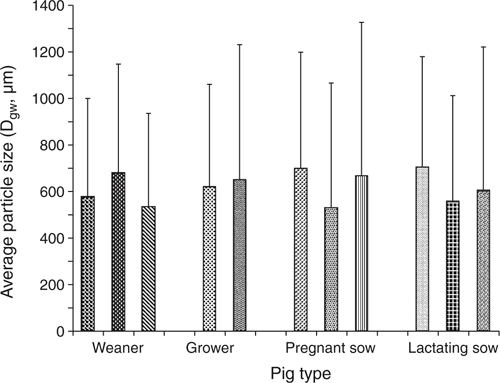Variation in particle sizes of commercial pig feeds in Vietnam
G. T. Nguyen A , W. L. Bryden A , M. J. Gidley A and P. A. Sopade A BA The University of Queensland, St Lucia, QLD 4072.
B Corresponding author. Email: p.sopade@uq.edu.au
Animal Production Science 55(12) 1565-1565 https://doi.org/10.1071/ANv55n12Ab136
Published: 11 November 2015
Feeds are formulated to supply animals with optimum energy and protein, and minerals and vitamins are added. In order to optimise feed digestibility, feed composition and processing are important. Milling is the first operation in feed processing, during which particle size is reduced and particle size distribution determined (Nguyen et al. 2013). Feed mills generate diverse particle sizes, as indicated in a survey of Australian feed mills (Nguyen et al. 2013). Previous studies in our laboratory highlighted the dependence of digestibility, and water absorption and solubility indices of grains on particle size and particle size distribution (Nguyen et al. 2015), and subsequent animal performance. The aim of this study was to characterise particle size of pig feeds in Vietnam, with a focus on southern regions, where the majority of feed mills are. It was hypothesised that particle size and its distribution would vary widely in Vietnamese pig feeds.
Forty-one mash pig feeds were collected from 11 mills in the Southeast and Mekong Delta regions. As in Nguyen et al. (2013) feeds were sieved, in duplicate, on-site using a manual-sieving device. Using methodology detailed in ASABE (2008), the volumes retained in the seven compartments of the device were recorded to calculate the geometric mean particle diameter (Dgw) and geometric standard deviation of mean particle diameter (Sgw). These results were presented without statistical analyses because feed ingredients were varied and not controlled.
Grains and ingredients were usually hammer-milled together, but the mills used different screen sizes. Irrespective of the feed, Dgw did not vary greatly (500–700 µm), and Sgw was 400–700 µm (Fig. 1). This observation could be due to the closeness of the screen sizes used by the mills (2.0–3.8 mm). However, 15 to 37% of the particles were larger than 1000 µm, and this could adversely affect feed efficiency. Findings from this study suggested that feed mills in Vietnam should monitor their products to ensure optimum particle size for animal feeds.

|
References
ASABE (2008) ‘Method of Determining and Expressing Fineness of Feed Materials by Sieving’. American Society of Agricultural and Biological Engineers. Niles Road, St Joseph, MI 49085-9659, USA.Nguyen GT, Bryden WL, Gidley MJ, Edwards AC, Willis S, Black JL, Wilson RH, Sopade PA (2013). Australasian Pig Science Association Manipulating Pig Production XIV, 55, eds JR Pluske and JM Pluske.
Nguyen GT, Gidley MJ, Sopade PA (2015) LWT – Food Science and Technology (Campinas.) 63, 541–549.
Supported in part by Pork CRC Limited Australia, AusAID and The University of Queensland.


